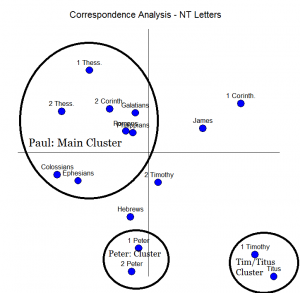The objective of carrying out correspondence analysis of New Testament letters is to find the sets of letters that belong together. Here the analysis is carried out using counts of various grammatical elements. This approach is open ended, with other elements able to be added into the exercise, as further analysis reveals other factors that can be taken into account
Correspondence Analysis is a technique for exploring the relationships between variables that can be represented in a two-dimensional table. In this case, the New Testament letters (excluding the letters of John and of Jude) have been analysed, with counts of the following grammatical elements having been extracted:
- Conjunctions
- Verbs in Subjunctive mood
- Participles
- Relative Pronouns
- Personal Pronouns
- Demonstrative Pronouns
- Definite Articles
- Adjectives
- Adverbs
- Prepositions
- Genitive Nouns
- All other words
Using this statistical technique it is possible to produce a graph that shows a weighted relative distribution of each of these elements in each of the letters, and through the wonders of modern mathematics it can reduce this down to a two dimensional graph.

One can see from this graph that most of Paul’s letters cluster together. This is not prima facie evidence that these letters were all produced by the same author; it is evidence it is likely that all of these letters were produced in the same educational mileau. Even if a letter is outside of this cluster, such as that of 1 Corinthians (and less significantly 2 Timothy, since it is close to the main cluster), it could indicate that the author was influenced by factors that are not applicable to the other letters.
It is interesting that both James and Hebrews are relatively close to the main cluster of Paul’s letters. This is an indicator that the writers of the Greek text of these letters were not so far removed, educationally, from Paul.
Surprisingly, the two letters of Peter cluster together, despite the fact that it is known that there were two different writers of the Greek texts of each of these letters. Nevertheless, it is conformable with the proposition, argued here and here that these letters were dictated by Peter in Aramaic and translated into Greek, while retaining the overall structure of Peter’s thoughts.
The two outliers are 1 Timothy and Titus. Both of these letters deal with Church order issues. This analysis supports the proposition that there letters were not written by Paul, but were written after his death.
